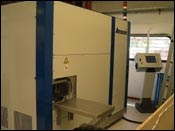Closed-Loop Cleaning
Patented process meets production requirements
The choice of a parts cleaning process is one that many plant engineers face at some time in their careers. A wise selection meets production needs and provides parts with the required level of cleanness to customers or to the next step in the process. A poor choice can lead to production bottlenecks and quality problems.
Case in point: Technoturn (Hastings, England), a producer of precision-turned parts for mainly automotive applications. The company’s investment in CNC turning machines led to strong growth and the ability to turn parts to 17 in diameter. But the higher output of its new turning equipment posed a problem when it came to cleaning all those parts.
Company director David McIlwain looked for an economical and environmentally friendly cleaning solution with minimal solvent consumption and fast cycle time, and found the EGAClean process from Amsonic Precision Cleaning (Biel, Switzerland).
The machine allowed for faster cleaning versus manual operation, and has resulted in cleaner parts, according to McIlwain. It handles Technoturn’s production over the weekend and is finished by Monday morning. “Our customers get clean parts, and we save manpower,” he says.
Amsonic’s EGAClean is based around a compact, high-capacity cleaning unit that uses a patented process combining non-chlorinated solvents under vacuum at high temperature, ultrasonics, and microfiltration of particles down to 50 μm in size. According to the company, the unit cleans, vapor degreases, dries and distills automatically in a closed loop.
The machine’s control includes 99 canned cleaning programs. Users select the required program after taking into account the type and amount of soil on their parts, the degree of cleanness required, and other factors. Solvent temperature can be varied to improve the solvency of difficult soils, and cycle times for the process typically vary from about 6 to 12 minutes.
Cleaning is said to be critical enough to allow operations such as plating, CVD and PVD coating, welding or gluing. The process leaves a nanofilm of isoparaffin that is said to protect clean parts against corrosion for approximately a month. The isoparaffin or modified alcohol solvents used are said to be almost indefinitely distillable, with annual solvent consumption of about 50 gal.
The process can also be automated; an automatic unit is equipped with roller conveyors, automatic basket covering and barcode program identification. In addition to cleaning programs, the machine control also has 15 maintenance programs that facilitate tasks such as emptying the distiller or changing the filter.
Technoturn uses isoparaffin solvent and a three-step process:
- Immersion cleaning in hot solvent (under vacuum over the flash-point) with ultrasonics and microfiltration
- Vapor phase
- Vacuum drying.
Related Content
-
Finishing Systems Provider Celebrates 150 Years, Looks to Future
From humble beginnings as an Indiana-based tin shop, Koch Finishing Systems has evolved into one of the most trusted finishing equipment providers in the industry.
-
Understanding PEO Coatings
Using high-speed cameras and back side illumination (BSI) sensor technology to analyze plasma electrolytic oxidation.
-
Understanding and Managing White Spots on Anodized Aluminum
Having trouble with spotting defects when anodizing? Taj Patel of Techevon LLC offers a helpful overview of the various causes of white spots and potential solutions.












.jpg;maxWidth=300;quality=90)




